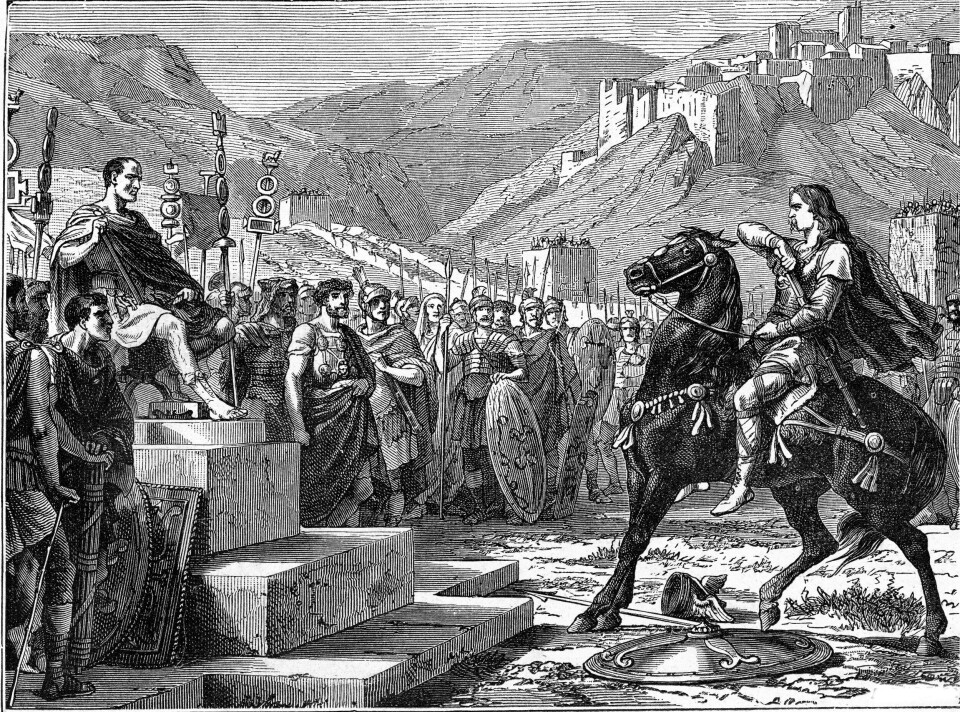-
One of the most notorious meals in the history of French gastronomy
How hard times inspired an outrageous festive feast in 1870
-
December events in France: art, fashion and the Titanic
Explore Gustave Courbet's masterpiece at Musée d’Orsay, 1920s fashion at La Piscine, Picasso Museum's expansion, and the Titanic exhibition in Lyon
-
Brouage: inland fortified French village was once a major European salt port
Some 400,000 tourists visit every year - many of whom are Canadian
Five French stories that mix history and myth - from Caesar to Clovis
Every nation embellishes their history to create legend. Here are five fables from the France’s past that have their roots in fact but might now be tall tales

1. The Surrender of Vercingetorix
After the decisive battle of Alesia in 52BC, the leader of the Gauls, Vercingetorix, is supposed to have thrown down his arms at Julius Caesar’s feet in a proud and dramatic gesture of submission, marking the inception of the Roman empire.
Caesar later wrote that the occasion was much more mundane and humiliating for his defeated foe.
In the Asterisk books, Vercingetorix throws his arms on Caesar’s feet causing him to hop around in agony – which is a much better story.
2. Vase of Soissons
After the battle of Soissons, the bishop of Reims begged Clovis I, king of the Franks, to spare a holy vessel, the Vase of Soissons.
One of Clovis’ men stepped forward and smashed the vase with his battle-axe.
Clovis said nothing.
One year later exactly, while Clovis was inspecting his troops he recognised the man, swung his own battle-axe and smashed the soldier’s head in with the words, “ Souviens-toi du vase de Soissons” (Remember the Vase of Soissons).
People are still arguing over what this story means.
3. Roland’s Last Stand
Roland was in charge of Charlemagne’s army’s rear guard when it was ambushed and massacred by Spanish Muslims (or Basques – take your pick) as it crossed the pass of Roncesvalles (Roncevaux).
With his last breath, Roland blew his hunting horn (olifant, a medieval word for elephant) to summon reinforcements but too late.
He died clutching Durandal, a sword with formidable powers with which he somehow created the Brèche de Roland (Roland’s Breach), a passageway through the rocks on the crest of the Pyrenees.
He then threw his sword into the cliff above Rocamadour, where you can still see it.
4. Baptism of Henry IV
According to tradition, when Henry of Navarre aka Henry of Bourbon, the future king of France, was born in the Château of Pau in 1553 he was given a “Bearnais Baptism”: his lips were rubbed with raw garlic and he was made to drink a cup of the local Jurançon white wine.
He was then laid in a turtle shell as a cradle, which is still on display in the chateau.
5. Flight to Varennes
At 7.55 on the evening of 21 March 1791, a coach arrived at the town of Sainte-Menehould in north-eastern France.
The postmaster thought there was something suspicious about the occupants. He checked; realised it was the royal family fleeing Revolutionary justice and sounded the alarm.
Most people will tell you that he recognised the king’s face from his portrait on a coin in his pocket but it was actually on a bank note, a 50 livre assignat.
Either way, it led to the arrest and trial of the king and the separation of said famous head from the rest of the body.
Related articles
Five historical French quotes (or mis-quotes) and their origins
May 1: Who do French people give muguet to and does it still matter?
























